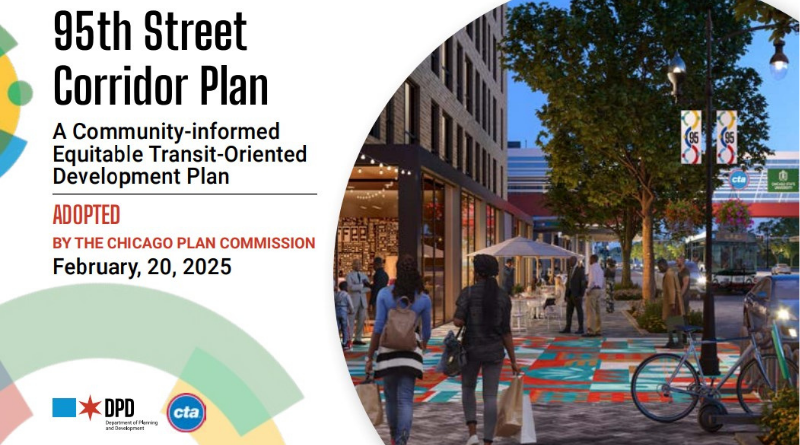The City of Chicago. (2025). The 95th Street Corridor Plan: A Community-informed Equitable Transit Oriented Development Plan.
The Chicago Plan Commission (CPC) adopted a detailed, community-informed, transit-oriented development (TOD) plan in February 2025, establishing fundamental principles for future growth and investment in the 95th Street Corridor. The plan outlines strategic measures to enhance walkability, improve transit access, expand wealth-building opportunities, and increase safety—all while preventing displacement and preserving community control over decision-making.
As a predominantly Black neighborhood on the South Side of Chicago, the 95th Street Corridor has endured the devastating effects of discriminatory housing and economic policies throughout the 20th century. These include the construction of the Dan Ryan Expressway through Lilydale—the historic heart of the area’s Black community—as well as redlining and contract buying. By emphasizing equity, this TOD model seeks to foster collaboration and meaningful dialogue with residents about how development may affect them, helping to mitigate future harm.
The CPC’s equity-focused development strategy prioritizes enhanced connectivity and reliable transit access. Planned transit investments include the rehabilitation of existing stations, such as the Metra Electric 95th Street Station and the Pace Pulse Station at 95th and Halsted. The plan also supports the CTA Red Line Extension—a $5.75 billion project—that will add four new stations and expand service 5.6 miles south to 130th Street. Safety upgrades for existing stations include improved lighting, new platforms, and accessible entrances. The plan also prioritizes individual transit options by expanding the existing bike network, adding protective barriers, and enhancing green spaces to improve aesthetics. Aside from aesthetic value, green spaces reduce street surface temperatures. This makes them an effective tool for improving pedestrian safety and experience, and combating the urban heat island effect, which disproportionately impacts low-income communities.

The 95th Street Corridor, like many neighborhoods in U.S. cities, faces a pressing affordable housing shortage. The CPC’s equity-focused framework has provided a platform for community members to express their most urgent concerns. Residents consistently identified the lack of affordable housing as a critical issue and emphasized the need to prevent displacement caused by gentrification. Since 2010, housing prices in the 95th Street Corridor have risen by 16 percent, suggesting that demand is outpacing supply. This imbalance stems largely from historic land-use practices, which rigidly designated parcels to specific uses and limited opportunities for mixed-use, walkable development.
The 95th Street Corridor is primarily zoned for single-family housing—restricting supply by limiting the number of housing units per parcel. The CPC’s plan explores ways to increase housing density in the area. It includes measures to protect existing housing stock and expand supply through infill development of vacant parcels. If implemented, policy will shift to encourage the construction of multi-family residences and townhomes, particularly at intersections with higher levels of commercial and pedestrian activity.
Alongside rental infill, the CPC aims to promote homeownership and generational wealth through the new townhome construction. The Chicago Housing Authority offers two programs to low-income families for achieving homeownership: A Down Payment Assistance program (DPA), which offers grants up to $10,000 to finance the purchasing of a home; and the Choose to Own program (CTO) which allows residents to convert housing subsidies into mortgage assistance. Community input indicates a strong preference for prioritizing homeownership over new rental units.
The CPC’s 95th Street Corridor TOD plan differentiates itself from conventional TOD models through its commitment to genuine community involvement. Unlike market-driven TODs—often led by private real estate developers—this plan is guided by local workshops and outreach efforts. These forums allow residents to share their concerns not only about current conditions but also about future challenges associated with various development styles. Community members are able to vote on preferred development approaches, adding a broader perspective to the planning process and helping ensure that investment aligns with their needs.
The 95th Corridor Plan website contains summaries, recordings, and slides from multiple community engagement sessions.

